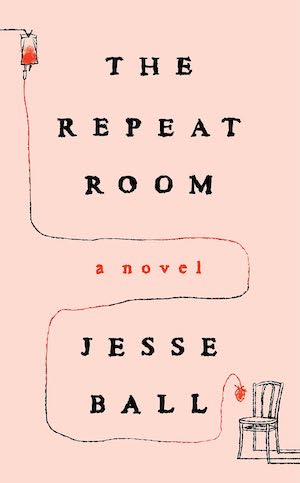Longtime readers of Jesse Ball’s surreal, philosophical fiction will know that he’s no stranger to dystopian terrain. His 2011 novel The Curfew was set in a city run by an authoritarian government that used—among other things—a curfew to maintain its power. In a number of ways, Ball’s new novel The Repeat Room feels like the author returning to certain themes, motifs, and devices that he’s reckoned with in earlier books, but combining them in disquieting ways.
The Repeat Room could accurately be described as a dystopian novel, but that isn’t its only concern. At its core, The Repeat Room represents Ball’s return to concepts he’s dealt with before. His 2014 novel Silence Once Begun reckoned with the aftermath of a mysterious crime in Japan and the circumstances that lead one man to confess to it. The protagonist of 2017’s How to Set a Fire and Why is, as its title suggests, a teenage arsonist. Those two novels were among Ball’s most realistic; The Repeat Room is set in a more speculative landscape, though it takes some time to realize just how different this world is from our own.
Initially, there’s something almost quotidian about the experience that Abel, this book’s protagonist, is having. If you’ve ever been called for jury duty, you’ve probably had the experience of watching an instructional video explaining how fulfilling one’s civic duty is important. (The first time I had jury duty in Brooklyn, the video we saw involved people in costumes re-enacting a colonial-era trial by ordeal, in which a bound defendant was tossed into a lake. It was weird.)
The Repeat Room opens with a man at a diner, looking at the courthouse where he’s been summoned for—let’s just call it “a version of jury duty” for now. This is Abel, a middle-aged man who works as a machinist. The first clue that we’ve gone far beyond the realm of what we’d consider a normal trial by jury comes when Abel is in the diner, when the woman working there speaks of the experience with foreboding, noting that the experience of the repeat room—something that hasn’t been defined at this point—is rumored to be lethal to some. The second comes after Abel has checked in at the courthouse, when he and a group of other prospective jurors change out of their clothing and into what Ball describes as “light-yellow-colored robes like hospital gowns, but more substantial.”
Soon enough, an official explains to Abel and his fellow jurors what they can expect. This part is training, the official explains. “[W]e will train you and in training you we will winnow you down until there is only one left.” Eventually, only one juror will remain; the case they will judge is a matter of life and death. And then, having been instructed, they’re given a glimpse of the accused, which will happen repeatedly during the process.
Buy the Book


The Repeat Room
It’s easy to imagine a version of this novel that traced out how society arrived at this point, and spelled out the idea of putting a death penalty case in the hands of a single juror. That isn’t how Ball tells this story, however. Instead, he guides the reader through the story from Abel’s level, and given that Abel is part of this society, there isn’t a lot of mulling over how things got to be this way. That said, aspects of the society do come up in dialogue from time to time, including the fact that this has replaced what’s referred to as “the primitive court system.” (Presumably, that’s our current system.) There’s an especially chilling moment during one instructional film when one speaker argues for the superiority of the system Abel is taking part in. It includes these two sentences, which made me gasp when I first read them:
“Mechanization and algorithmic control means freedom to just participate in the act of being human. More and more we see what that means is deciding who gets to be human.”
The device of instructional films and tutoring provides Ball with an in-story way to get in some details about the worldbuilding of this justice system, but it serves a narrative function besides window dressing for exposition. This is a book concerned with questions of crime and punishment: the circumstances that might lead someone to break the law and the way that society responds.
Based on his bibliography alone, it’s clear that Ball has spent a lot of time thinking about these questions. The device of the repeat room itself, in which the juror experiences the life of the accused standing trial, is one of several ways in which these two roles become blurred. At times, the officials’ manner with Abel is brusque and accusatory; there are scenes where, viewed in isolation, you might assume Abel is the one on trial. There’s a running motif of social capital here; in his conversations with the officials, the matter of Abel’s low social standing—and how that might be reversed—is raised.
Ball’s approach echoes the immersive elements of the story he’s telling here. This is an immersive and sometimes disorienting book, speculative fiction in the purest sense but also a work of fiction that takes big structural risks. The Repeat Room isn’t solely a book about capital punishment, but it does feel like a way to heighten certain elements of the debate over it, all the while reckoning with some of its author’s themes of choice. If you’re encountering Ball’s work for the first time here, you’re in for a challenging but rewarding read. And if you’re a longtime reader of Ball’s bibliography, The Repeat Room might spur some repeat reading of his other novels.
The Repeat Room is published by Catapult.










